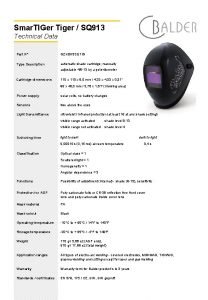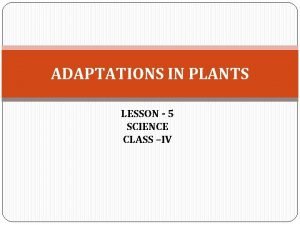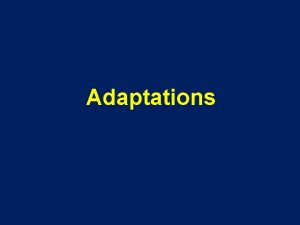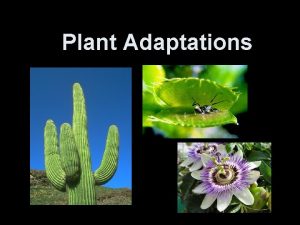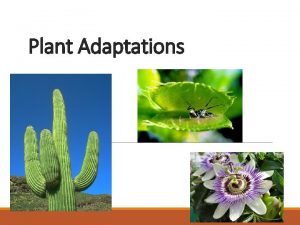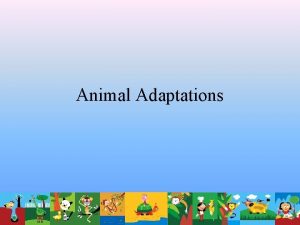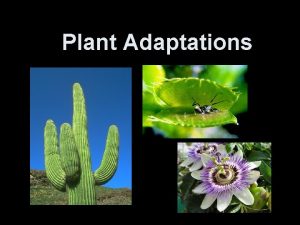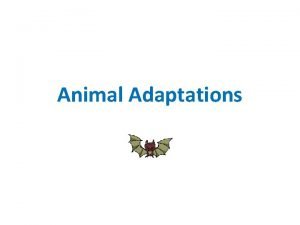Science 913 Adaptations Adaptation n n An adaptation











- Slides: 11

Science 913 Adaptations

Adaptation n n An adaptation is a trait that helps a plant or an animal survive. Let’s take a look and some skulls to see how these help the animal to survive.

Beaver Skull A beaver is a herbivore (plant eater) and has adaptations that allow it to crush and grind tough plant fibres.

Adaptations Help Beaver Survive large bones protect vital organs such as the eye. A blind beaver would soon be eaten by a coyote or other predator Incisors – the beaver using these teeth to cut down trees and peel bark. If they do not grind these teeth down, they will grow through its skull and into its brain. Large muscles attach to these ridges. Large muscles are an adaptation that helps the beaver to cut down trees and branches Flat molar teeth have many ridges. Flat molar teeth are an adaptation that enables this herbivore to grind up the tough plant material.

Coyote Skull A coyote is a carnivore (meat eater). It has teeth that are adaptations that help this predator catch, kill, and eat prey.

Adaptations help coyote survive Large ridges in the head – muscles attach to these points. Large muscles are an adaptation that allows the coyote to catch, kill, and eat its prey. Large canines help this animal catch, hold, and kill it prey. They are adaptations of this predator. Pointed molars are adaptations because they help the coyote to chew food into small pieces. scissor teeth – these are large teeth that act like a pair of scissors. When the coyote chews, these teeth slice the meat into pieces that this predator can swallow

Moose jaw/teeth A moose is a herbivore. Like the beaver, the moose has large, flat molar teeth. These teeth are an adaptation because they allow the moose to grind up tough plant fibres.

Cougar A cougar is a carnivore. It has a number of adaptations that allow it to catch, kill, and eat its prey. Ears and hearing – cats have keen sense of hearing. This is an adaptation because it allows the cougar to hear potential prey and to warn it if danger is in the area. Forward pointing eyes and very good vision help this cat to see prey. They also help the animal when it is chasing its victim. Strong muscles are an adaptation because they allow the cougar to run fast and to jump. This adaptation helps this cat to catch prey and to escape from potential predators.

Coniferous Trees also have adaptations that help it to survive.

Adaptations of coniferous trees The pyramid shape and the needles help it to shed heavy, wet snow. This reduces the chances that the tree will break or be damaged. Root systems absorb water and other nutrients from the soil. Most coniferous trees do not shed their leaves (needles) at one time. They are able to make food (photosynthesis) all year round. Squirrels and other animals eat the seeds found inside the pine cone. They spread these seeds to other parts of the forest. The seeds may grow into a new tree.

Write this down! n n n 1. Use clip art or the Internet to find a picture of an animal or a plant that interests you (domestic or wild) – other than the ones we looked at today. 2. Write a paragraph that describes the “adaptations” of your animal or plant. 3. If possible, send Mrs. Sacher a copy of your short report.
 Sqtor
Sqtor Sq 913
Sq 913 Council framework decision 2008/913/jha
Council framework decision 2008/913/jha What's your favorite subject at school
What's your favorite subject at school What is adaptation in science
What is adaptation in science Adaptation of plants in hilly areas
Adaptation of plants in hilly areas Natural vs social science
Natural vs social science What are the main branches of natural science
What are the main branches of natural science Natural and physical science
Natural and physical science Applied science vs pure science
Applied science vs pure science Natural science and social science similarities
Natural science and social science similarities Sciencefusion think central
Sciencefusion think central

